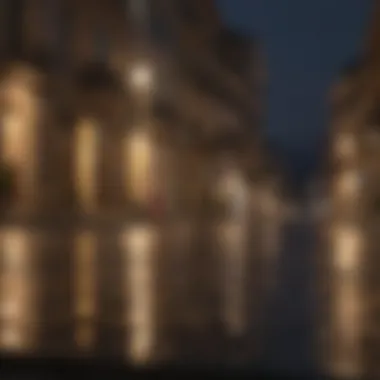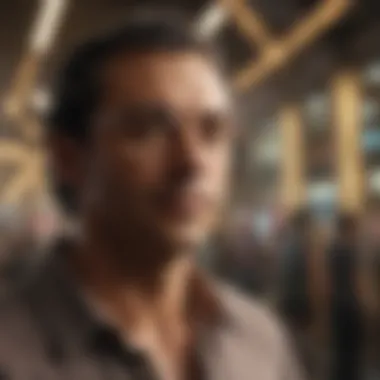Exploring M. Night Shyamalan's Cinematic Journey


Intro
M. Night Shyamalan is a name that evokes strong reactions from film enthusiasts. Whether admired for his mastery of suspense or critiqued for his polarizing stories, his filmography invites a close examination. From the moment The Sixth Sense captivated audiences with its chilling twist, Shyamalan has been both a defining voice and a controversial figure within the film industry. His storytelling often dances on the edge of the supernatural, forcing viewers to engage with complex moral dilemmas and the weight of personal choice.
As we venture through his body of work, it becomes apparent that his films do more than entertain; they challenge conventions and beckon deeper reflection. Shyamalan’s signature plot twists are not merely gimmicks but serve as vehicles for exploring profound themes. The juxtaposition of ordinary life against extraordinary circumstances highlights the uncharted territories of fear, faith, and identity. An exploration of his films reveals a distinctive narrative style, where suspense is interwoven with character-driven stories.
This article aims to provide insights into the elaborate worlds crafted by Shyamalan. It will parse through his earlier triumphs and more recent works, assessing how his films have evolved. Critical reception, both positive and negative, will be examined, shedding light on the impact he has had on contemporary cinema. As we delve further, the aim is to paint a complete picture of the cinematic universe that M. Night Shyamalan has built over decades.
Prologue to M. Night Shyamalan
The cinematic landscape is often shaped by directors who push boundaries, ignite conversations, and challenge conventions. M. Night Shyamalan is undeniably one of those filmmakers whose mark on the industry cannot be overlooked. From crafting suspenseful narratives to exploring the complexities of fear and human nature, his work offers a unique lens through which to examine modern cinema. Understanding Shyamalan's journey—from his roots in suburban Philadelphia to his rise as a master of plot twists—reveals the intricacies of storytelling that resonate with audiences both young and old.
Background and Early Life
M. Night Shyamalan was born on August 6, 1970, in Mahé, India, before his family immigrated to the United States. Growing up, his Indian heritage played a significant role, instilling a unique viewpoint that would later translate into his films. Living in a culturally diverse neighborhood in Penn Valley, Pennsylvania, Shyamalan was exposed to different narratives and perspectives, contributing to his imaginative storytelling.
As a child, he became fascinated with film at an early age, directing short movies using his father's camcorder. By the age of 19, he had already begun to hone his skills, writing and directing his first film, "Praying with Anger," during his college years. This film turned out to be a small stepping stone, blending his cultural background with cinematic ambition. Shyamalan's upbringing laid the groundwork for his future in filmmaking, where elements of his personal experiences would later become interwoven into the complex tapestry of his cinematic universe.
Rise to Prominence
Shyamalan's ascent to fame was meteoric. His breakout hit, "The Sixth Sense," released in 1999, became a cultural sensation, earning him two Academy Award nominations. The film's signature twist and emotional depth struck a chord with audiences, pushing it into the realm of modern classics. It was not just a film; it was a phenomenon that engaged viewers in a dialogue about the nature of life and death.
Following that, Shyamalan continued to impress with films like "Unbreakable," which carefully subverted superhero genre conventions, and "Signs," which tackled themes of faith and familial bonds amidst extraterrestrial chaos. These films not only showcased his ability to build suspense but also his talent for layering philosophical questions within thrilling narratives.
Shyamalan's signature approach—intertwining supernatural elements with human psychology—has made his body of work distinctly recognizable. Critics and fans alike are drawn to his knack for creating unexpected endings while engaging deep themes. As his career progressed, Shyamalan embraced themes of isolation and identity, further solidifying his status as a unique voice in contemporary cinema.
Through this exploration of his background and rising prominence, it's clear that M. Night Shyamalan's journey reveals an indefatigable spirit of creativity. His ability to connect profound themes with suspenseful storytelling continues to inspire both emerging filmmakers and seasoned veterans in the film industry.
Signature Themes in Shyamalan's Work
M. Night Shyamalan’s storytelling is plastered with themes that echo through his filmography. These recurring motifs serve not just as a backdrop but as a vessel for deeper examination of the human condition. Understanding the signature themes in his work enables viewers to dissect and interpret the layered narratives he constructs, illuminating both the craft of filmmaking and the complexities of life.
Fate and Destiny


Fate and destiny are threads that weave through many of Shyamalan's films. They prompt viewers to ponder how much control one truly has over their life. In Unbreakable, the character David Dunn grapples with the realization that he may be destined for greatness—or perhaps something darker. The theme here lies not only in the acceptance of one's calling but also in challenges that must be faced. Shyamalan forces us to reckon with the idea that our choices might be less random than we like to think. The audience is left to wonder about the unseen forces at play in their own lives.
"Life is a tapestry of fate, each strand tightly woven into the fabric of our existence."
The Exploration of Fear
Fear is another cornerstone of Shyamalan's cinematic universe. He delves into the psyche, urging viewers to confront both tangible and intangible fears. The film Signs exemplifies this thematic exploration. Here, the characters' fear of the unknown is portrayed not just through alien invasions but also through their personal struggles with faith and doubt. Shyamalan adeptly utilizes suspense, building tension as the characters face their fears head-on. His clever manipulation of sound, light, and editing creates an unnerving atmosphere, making every creak of the floorboard a potential harbinger of doom. His message resonates: fear can paralyze or catalyze, and it is the choices made in those pregnant moments that define us.
Isolation and Community
Isolation is often at odds with the need for community in Shyamalan's films. Characters frequently find themselves on the fringes, battling personal demons while yearning for connection. In The Village, the isolation felt within the community acts as a protective measure against perceived dangers. However, this self-imposed seclusion leads to walls being built—both literally and metaphorically. The characters create an environment where fear dictates their interactions, ultimately leading them to question what true safety means. Shyamalan invites us to think about our own relationships and communities. Are we isolating ourselves to avoid fear, or can we open up to build strength together?
These themes weave a rich tapestry that captures not just the fantasy and thrill of Shyamalan's storytelling but also the essence of human experience in all its complexity. Each layer of his cinematic universe beckons us to both examine ourselves and the world around us.
An In-Depth Analysis of Key Films
M. Night Shyamalan’s films are often more than just stories—they're intricate webs woven with layers of meaning, emotions, and philosophical musings. Examining these key films offers not just an appreciation of his narrative style but also insights into the evolution of modern cinema. Shyamalan's psychological tension and character development reflects societal fears and personal dilemmas, making this analysis crucial for understanding his cinematic universe.
The Sixth Sense: A Cultural Phenomenon
Upon its release in 1999, The Sixth Sense became a hallmark of psychological thrillers, captivating audiences with its unexpected twist. The tagline, “I see dead people,” instantly embedded itself in pop culture, sparking numerous discussions and parodies. This film laid the groundwork for Shyamalan's career, showcasing his flair for suspense and emotionally resonant storytelling. The exploration of grief and unresolved trauma is artfully depicted through the character of Cole Sear, a boy haunted by his abilities. In doing so, it elevates the narrative from simple horror to a profound commentary on life itself.
Unbreakable: Deconstruction of Superhero Narratives
In Unbreakable, Shyamalan shifted the superhero genre on its head. Rather than glorifying superpowers, he delved into the psychological aspects of heroism and villainy through David Dunn and Elijah Price. The film subtly critiques the conventions of comic book lore, challenging viewers to rethink what being a hero truly means. By framing the narrative in a real-world context, he presents the extraordinary as a reflection of the ordinary. The nuanced character development and moral ambiguity push boundaries, ultimately questioning notions of fate and self-identity.
Signs: Faith and Skepticism
Signs, starring Mel Gibson and Joaquin Phoenix, is a poignant exploration of faith amidst uncertainty. The film juxtaposes the awe and fear associated with the unknown, incorporating alien invasion as a metaphor for personal crises. Graham Hess’s journey from belief to skepticism and back again resonates deeply with those grappling with existential questions. Shyamalan crafts tension through minimalism, using silence and stillness to amplify the stakes. This film challenges viewers to ponder their beliefs and the nature of evidence in an increasingly skeptical world.
The Village: The Nature of Truth
With The Village, Shyamalan examines societal constructs and the lengths we go to protect our communities. Set in a seemingly idyllic village, the film reveals the darkness that lies beneath veneer of peace. The decision to maintain an isolated existence raises questions about trust, fear, and authority. By blending elements of suspense with social commentary, Shyamalan critiques the human tendency to manipulate truths for comfort. The climactic twist not only reframes the narrative but also underscores the complexities of perception and reality.
Split: The Complexity of Identity


In Split, Shyamalan tackles the intricate concept of identity through the lens of dissociative identity disorder. James McAvoy’s portrayal of Kevin Wendell Crumb highlights the struggle between the different facets of the self, creating a chilling yet compelling narrative. The film addresses not merely the fear of the monstrous but also the longing for understanding and acceptance. The psychological underpinning of Kevin's condition prompts a discussion on the stigma surrounding mental health, making this film a stark exploration of the human psyche.
Glass: Connecting Past Narratives
Glass serves as the capstone of Shyamalan’s superhero trilogy, merging the narratives from Unbreakable and Split. This film is ambitious, tackling the idea of society's perception of heroes and villains while also examining their inherent vulnerabilities. Shyamalan dives deep into themes of control and manipulation, inviting audiences to question the narratives imposed upon them. The film’s intricate connections reveal the beauty in the complexity of these characters, ultimately culminating in a dialogue around destiny and choice.
Old: Reflections on Time and Aging
In Old, Shyamalan presents a chilling take on the passage of time and its effects on human life. By placing characters in a situation where they age rapidly, he explores themes of mortality, regret, and the fleeting nature of existence. The film emphasizes the urgency of time and the importance of cherishing moments, making it a poignant commentary on life’s transience. The narrative unfolds with a sense of inevitability, encouraging viewers to reflect on their own journey through the different stages of life.
"Time is a thief; it steals the moments we hold dear."
This phrase encapsulates the essence of Old, making it a reflective piece that resonates deeply with individuals at any age.
Shyamalan's Unique Narrative Techniques
The narrative techniques employed by M. Night Shyamalan are not just elements of his storytelling; they are the threads that weave the intricate tapestry of his cinematic universe. Understanding these techniques is crucial for appreciating the depth of his work. Shyamalan stands apart from other filmmakers through his ability to combine subtlety with powerful twists, which invites viewers to engage with his stories on multiple levels.
Subtle Storytelling
Shyamalan has a knack for embedding minor details into the fabric of his films, often creating a rich experience without overwhelming his audience with information. For instance, in The Sixth Sense, the color red is subtly interspersed throughout the film, marking moments of emotional significance or revealing supernatural elements. This technique helps to build tension and keeps viewers on their toes, making them wonder about the significance of even the smallest details.
This approach demands active participation from the audience; viewers have to pay attention and think critically. It transforms passive watching into an immersive experience. Just when viewers think they understand the narrative, the subtle details may pivot the storyline in an unexpected direction. The satisfaction comes, not just from the resolution, but from piecing together the clues that lead to it.
Moreover, Shyamalan often uses silence as a storytelling tool, creating a sense of tension or foreboding. Silence in his films can speak volumes; it builds anxiety and anticipation, making the audience feel the weight of decisions or moments of realization. This nuanced approach to storytelling is vital, as it aligns with the psychological dimensions of fear and the human condition that Shyamalan frequently explores.
Twists and Their Implications
The twist ending has become a hallmark of Shyamalan’s films. However, he does not use twists merely as shock value. Instead, they serve to redefine the entire narrative, urging viewers to reconsider what they have witnessed. The twist at the end of Unbreakable, for example, recontextualizes the characters and their motivations. It invites an examination of identity and destiny—two recurring themes in Shyamalan's filmmaking.
Twists are not just about surprise; they are about revelation. They challenge the viewer’s assumptions and encourage a deeper reflection on the narrative’s construction. When well-executed, a twist allows the entire viewing experience to blossom anew. The audience realizes how carefully the story has been crafted and how the revelations alter their previous interpretations.
In addition, Shyamalan’s twists often carry ethical or philosophical implications that linger long after the credits roll. They encourage discussions about morality, the nature of evil, and the intersection of fate and free will. For fans of pop culture, this turns movies into forums for debate and exploration, fostering a community that seeks to analyze the layers beneath the surface.


"Art is never finished, only abandoned." – Leonardo da Vinci
Critical Reception and Audience Response
The reception of any filmmaker's work plays a pivotal role in shaping their narrative legacy, and M. Night Shyamalan's films are no exception. His cinematic journey has been a rollercoaster of critical acclaim, intense scrutiny, and a fervent fanbase that has evolved alongside his body of work. In exploring Shyamalan’s critical reception and audience responses, we can gain insight into how public opinion shifts over time and how that reflects on the artist’s trajectory.
Initial Acclaim and Later Critique
When Shyamalan burst onto the scene with The Sixth Sense, he didn’t just grab attention; he secured a place in the cultural zeitgeist. Critics hailed the film for its storytelling finesse and the unprecedented twist at the end, and it quickly became a blueprint for psychological thrillers. The film's haunting atmosphere and Bruce Willis' understated performance contributed to its success, leading it to be one of the highest-grossing movies of its era. Critics like Roger Ebert praised its originality, cementing Shyamalan as a force to reckoned with in Hollywood.
However, as Shyamalan’s career progressed, the initial ascendance met with some turbulence. Films such as Lady in the Water and The Happening were met with harsh reviews. Critics were less forgiving, often citing cringe-worthy performances or convoluted plots that caused audiences to scratch their heads. The backlash from these projects often painted Shyamalan as a once-brilliant filmmaker who had lost his touch. This shift in reception underscores a significant aspect of Shyamalan’s career: the danger of expectation.
"M. Night Shyamalan has become a cautionary tale about the pitfalls of hype; people went from loving his twist endings to eagerly anticipating his failures."
Cult Following and Revival
Despite the ups and downs, Shyamalan has cultivated a devoted cult following. This dedicated base has found beauty and depth in his films that casual viewers often miss. The way he handles suspense, his skill in weaving psychological complexity, and often his brave choice to tackle unconventional narratives resonate with many who appreciate film as an art form. Fans rally together in discussions across platforms like Reddit, celebrating his unique vision while pointing out hidden layers in films that mainstream critics may overlook.
As Shyamalan moved into the 2010s with The Visit and Split, a revival of sorts took place. These films reminded audiences of his penchant for unexpected storytelling and complex characters. Critics began to re-evaluate earlier works and found merit where they had once seen failure. The shift in perception not only highlights how audiences can grow in their understanding of a filmmaker’s intent but also reflect how time can alter narratives around success and failure in the film industry.
Closure: Shyamalan's Legacy
The cinematic legacy of M. Night Shyamalan is a layered tapestry woven with themes of suspense, introspection, and a masterful command of narrative structure. His films are not mere entertainment; they are profound explorations of the human experience, provoking viewers to delve deeper into their own lives. Here, we will explore the critical impact his work has made on modern cinema and what lies ahead for this talented filmmaker.
Impact on Modern Cinema
Shyamalan has left an indelible mark on the landscape of contemporary film. His ability to blend elements of thriller and drama while incorporating unexpected twists has reshaped audience expectations. In an era where predictability often reigns, Shyamalan’s narratives compel one to reconsider the narrative arcs of mainstream cinema. Key effects of his influence include:
- Reinvigoration of the Thriller Genre: Shyamalan’s knack for cultivating suspense has rejuvenated interest in psychological thrillers. Films like The Sixth Sense and Signs showcase how a tension-building atmosphere can overshadow even the most fantastic elements.
- The Power of the Twist: From the origination of Shyamalan’s signature twist endings, filmmakers started to experiment with storytelling techniques more boldly, seeking to subvert audience expectations. This has led to a new trend in narratives that often question the very nature of truth and perception.
- Cultivating a Thoughtful Audience: Shyamalan’s films often demand more of their viewers. They are not simple watch-and-forget experiences; they inspire discussions about themes like isolation, faith, and the reliance on community. This has prompted filmmakers to explore more profound themes, reflecting the desires of an increasingly discerning audience.
"It's not just about what you see on the screen. It’s about what the story makes you feel and question."
— M. Night Shyamalan
Future Projects and Directions
As the world of cinema evolves, so does Shyamalan’s vision for his work. Upcoming projects hint at a continued commitment to bending genres and defying expectations. With the rise of streaming platforms and an ever-shifting distribution landscape, possible directions include:
- Exploration of New Mediums: Shyamalan is rumored to be developing stories for streaming services, which would allow for more expansive storytelling. The flexibility of episodic formats could well lead him to dive into deeper character explorations and intricate plots over a longer narrative arc.
- Engaging with Modern Issues: His recent films often touch upon societal anxieties, such as the passage of time in Old. Future projects might tackle even more pressing contemporary issues, drawing parallels to current societal challenges, thus enhancing relatability and depth.
- Collaborations with Emerging Talent: With a growing interest in indie films, Shyamalan might seek partnerships with fresh voices in cinema, diversifying his storytelling palette. This could lead to innovative narratives that combine his established cinematic language with new cultural perspectives.
In summation, M. Night Shyamalan’s legacy within the realm of modern cinema cannot be overstated. He champions a style that prioritizes emotional connection over mere spectacle. His upcoming ventures and the impact of his past works will likely continue to inspire filmmakers and audiences alike, making it clear that Shyamalan's journey in the cinematic universe is far from over.
For further reading on Shyamalan’s work, you can check out the following resources: Wikipedia on M. Night Shyamalan, Britannica Overview and discussions on Reddit.



